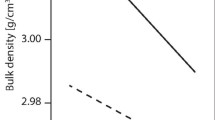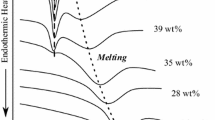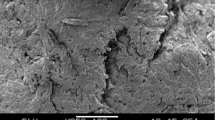Abstract
The purpose of this research was to evaluate the relation between preferential direction of pores and mechanical strength of cubic starch compacts. The preferential pore direction was quantified in SEM images of cross sections of starch compacts using a previously described algorithm for determination of the quotient of transitions (Q). This parameter and the mechanical strength were evaluated in compacts of different porosities. Starch was chosen as a model compound for materials with ductile behaviour of which tablets with low porosities can be made and which shows some elastic recovery after compaction. At medium and high porosity Q was significantly higher in the images providing a side view of the compact than in the images providing a top view (0.973 vs. 0.927 and 0.958 vs. 0.874 at 0 mm from the side of the compact and 0.956 vs. 0.854 and 0.951 vs. 0.862 at 3.5 mm), indicating that the pores were mainly oriented in the direction perpendicular to the direction of compression. This was accompanied by a lower crushing force in this direction. This could be explained by considering the pores as cracks which propagate through the sample during crushing. For both directions the crushing force decreased with increasing porosity. The yield strength of the compacts also decreased with increasing porosity, but this parameter was not dependent on the direction of crushing when the porosity was below 10%. The results show that pore direction significantly influences the crushing force but does not influence the yield strength, at porosities below 10%.






Similar content being viewed by others
References
K. van der Voort Maarschalk, and G. K. Bolhuis. Improving properties of materials for direct compression. Pharm. Technol. 23:34–38 (1999).
B. Johansson, M. Wikberg, R. Ek, and G. Alderborn. Compression behaviour and compactability of microcrystalline cellulose pellets in relationship to their pore structure and mechanical properties. Int. J. Pharm. 117:57–73 (1995).
M. Eriksson, and G. Alderborn. The effect of original particle size and tablet porosity on the increase in tensile strength during storage of sodium chloride tablets in a dry atmosphere. Int. J. Pharm. 113:199–207 (1995).
R. W. Rice. Relation of tensile strength–porosity effects in ceramics to porosity dependence of Young's modulus and fracture energy, porosity character and grain size. Mat. Sci. Eng. A-Struct. A112:215–224 (1989).
E. Ryshkewitch. Compression strength of porous sintered alumina and zirconia. J. Am. Ceram. Soc. 36:65–68 (1953).
W. H. Duckworth. Discussion of Ryshkewitch paper by Winston Duckworth. J. Am. Ceram. Soc. 36:68 (1953).
J. M. Newton, G. Alderborn, and C. Nyström. A method of evaluating the mechanical characteristics of powders from the determination of the strength of compacts. Powder Technol. 72:97–99 (1992).
G. Alderborn, and C. Nyström. Studies on direct compression of tablets IV. The effect of particle size on the mechanical strength of tablets. Acta Pharm. Suec. 19:381–390 (1982).
T. Ando, H. Yuasa, Y. Kanaya, and K. Asahina. Studies on anisotropy of compressed powder. III. Effects of different granulation methods on anisotropy, pore size and crushing strength of tablets. Chem. Pharm. Bull. 31:2045–2054 (1983).
G. Alderborn, and C. Nyström. Radial and axial tensile strength and strength variability of paracetamol tablets. Acta Pharm. Suec. 2:1–8 (1984).
S. Malamataris, T. Hatjichristos, and J. E. Rees. Apparent compressive elastic modulus and strengths isotropy of compacts formed from binary powder mixes. Int. J. Pharm. 141:101–108 (1996).
C. Nyström, K. Malmquist, and J. Mazur. Measurement of axial and radial tensile strength of tablets and their relation to capping. Acta Pharm. Suec. 15:226–232 (1978).
J. M. Newton, G. Alderborn, C. Nyström, and P. Stanley. The compressive to tensile strength ratio of pharmaceutical compacts. Int. J. Pharm. 93:249–251 (1993).
K. Kachrimanis, and S. Malamataris. Compact size and mechanical strength of pharmaceutical diluents. Eur. J. Pharm. Sci. 24:169–177 (2005).
G. Alderborn, E. Borjesson, M. Glazer, and C. Nyström. Studies on direct compression of tablets XIX. The effect of particle size and shape on the mechanical strength of sodium bicarbonate tablets. Acta Pharm. Suec. 25:31–40 (1988).
S. Galen, and A. Zavaliangos. Strength anisotropy in cold compacted ductile and brittle powders. Acta Mater. 53:4801–4815 (2005).
M. P. Mullarney, and B. C. Hancock. Mechanical property anisotropy of pharmaceutical excipient compacts. Int. J. Pharm. 314:9–14 (2006).
J. T. Fell, and J. M. Newton. Determination of tablet strength by the diametral-compression test. J. Pharm. Sci. 59:688–691 (1970).
E. H. Andrews. Fracture phenomena in polymers I. In E. H. Andrews (ed.), Fracture in polymers, Oliver and Boyd, Edinburgh, 1968, pp. 37–73.
I. M. Ward. Review: the yield behaviour of polymers. J. Mater. Sci. 6:1397–1417 (1971).
Y. S. Wu, H. W. Frijlink, L. J. van Vliet, I. Stokroos, and K. van der Voort Maarschalk. Location dependent analysis of porosity and pore direction in tablets. Pharm. Res. 22:1399–1405 (2005).
http://www.diplib.org. (accessed 7/1/07).
T. Q. Pham, and L. J. van Vliet. Separable bilateral filtering for fast video preprocessing. in Proc. IEEE Int. Conf. on Multimedia & Expo. 2005. Amsterdam.
K. van der Voort Maarschalk, H. Vromans, G. K. Bolhuis, and C. F. Lerk. The effect of viscoelasticity and tabletting speed on consolidation and relaxation of a viscoelastic material. Eur. J. Pharm. Biopharm. 42:49–55 (1996).
J. E. Rees, and K. D. Tsardaka. Some effects of moisture on the viscoelastic behaviour of modified starch during powder compaction. Eur. J. Pharm. Biopharm. 40:193–197 (1994).
K. van der Voort Maarschalk, H. Vromans, W. Groenendijk, G. K. Bolhuis, and C. F. Lerk. Effect of water on deformation and bonding of pregelatinized starch compacts. Eur. J. Pharm. Biopharm. 44:253–260 (1997).
M. F. Ashby, and S. D. Hallam. The failure of brittle solids containing small cracks under compressive stress states. Acta Metall. 34:497–510 (1986).
C. E. Renshaw, and E. M. Schulson. Universal behaviour in compressive failure of brittle materials. Nature. 412:897–900 (2001).
Author information
Authors and Affiliations
Corresponding author
Rights and permissions
About this article
Cite this article
Wu, Y.S., van Vliet, L.J., Frijlink, H.W. et al. Pore Direction in Relation to Anisotropy of Mechanical Strength in a Cubic Starch Compact. AAPS PharmSciTech 9, 528–535 (2008). https://doi.org/10.1208/s12249-008-9074-4
Received:
Accepted:
Published:
Issue Date:
DOI: https://doi.org/10.1208/s12249-008-9074-4




